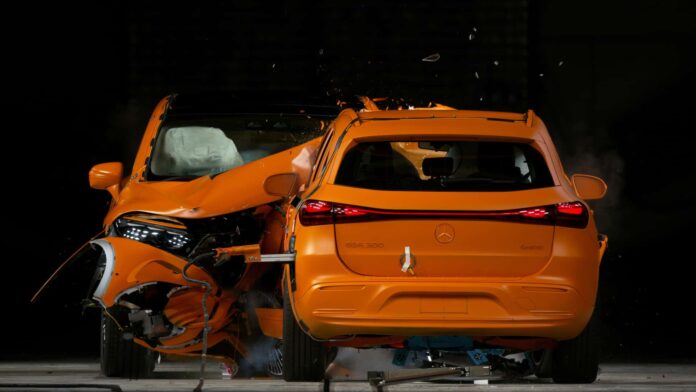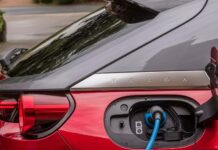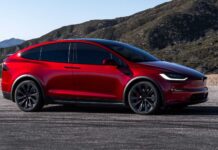[ad_1]
Two 49-kilogram female dummies, around 1.5-meters tall, wearing red t-shirts and white shoes escaped relatively unscathed after the electric vehicles they were driving collided head-on. Mercedes-Benz claims it was the world’s first crash test involving two pure EVs.
The automaker wanted to go “above and beyond” the legal requirements to discover what happens when two EVs collide head-on, which is why it crash-tested an EQS 450 SUV and an EQA 300 head-on at the Group Technology Centre for Vehicle Safety in Sindelfingen, Germany.
The electric SUV, weighing 3.0 tonnes, and its smaller sibling, weighing 2.2 tonnes, hurled towards each other at 35 miles per hour with a 50 percent frontal overlap – an offset instead of a perfectly aligned collision – to replicate common accidents on rural roads like mishaps while overtaking, the automaker said.
There were four dummies in total, all equipped with up to 150 sensors each. After the crash, Mercedes-Benz engineers discovered a low risk of serious to fatal injury. The real-life test corroborated what engineers found in numerous computer simulations ahead of the test. Most importantly, the high-voltage system cut off automatically, and the batteries in both EVs remained intact.
In the cinematic slow-motion footage above, you can see how the EQA rebounds more aggressively after colliding with the bigger and heavier EQS SUV. As they crash, debris from the bumpers, hoods, and frontal crash structures gets spewed violently onto the scene as the airbags deploy almost instantly. Crucially, the passenger compartment remains intact as well.
Vehicle crumple zones up front are designed to absorb impact energy, which is why they appear destroyed upon collision. When the majority of the kinetic energy gets dissipated within the crumple zones, the risk of energy bleeding into the passenger compartment is reduced. This of course would vary upon the nature and the circumstances of a crash.
As a reminder, both EVs have a five-star Euro NCAP safety rating but haven’t been tested by the National Highway Safety Administration (NHTSA) and the Insurance Institute for Highway Safety (IIHS) yet.
However, low risk doesn’t mean no risk, and the results of one controlled crash aren’t indicative of countless other real-world scenarios. But to Mercedes-Benz’s credit, the recent undertaking is a positive step in taking EV safety more seriously as an increasing number of cars with heavy batteries and high voltage systems pour onto roads worldwide.
Crash tests of this nature could help automakers assess the safety of high-voltage components and energy-dense batteries, understand how these components behave under extreme circumstances and can be crucial for ensuring the safety of occupants and first responders. We’ve already seen on multiple occasions how EV fires are hard to extinguish due to thermal runaways.
“We don’t just want zero traffic fatalities by 2050 and half the number of traffic fatalities and serious injuries by 2030 compared to 2020. Our goal by 2050 is zero accidents involving a Mercedes-Benz vehicle,” said Markus Schäfer, the chief technology officer and member of the board of management of Mercedes-Benz Group AG.
[ad_2]
Source link
















